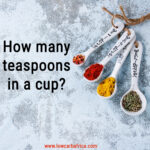How Many Ounces in a Tablespoon?
Introduction
Understanding the relationship between tablespoons and ounces is crucial for precise measurements in the culinary world. Whether you’re following a recipe, working in a kitchen, or measuring liquids for any purpose, knowing how to convert between these units is essential. In this article, we will explore the conversion factor, applications, historical origins, and other key details related to converting tablespoons to ounces.
Understanding Tablespoons and Ounces
Tablespoons and ounces are both units of volume, primarily used in the context of cooking or serving sizes. A tablespoon, abbreviated as “tbsp”, is commonly used worldwide, with its volume varying slightly from region to region. The US customary tablespoon is approximately 14.8 milliliters, while the British imperial tablespoon is larger at 17.76 milliliters.An ounce, on the other hand, can represent either a unit of weight or volume in the British and American systems of measurement. Specifically, in the context of volume, a fluid ounce (fl oz) in the US system is approximately 29.57 milliliters, whereas the British imperial fluid ounce is larger, at around 28.41 milliliters.
Conversion Process
When converting from tablespoons to ounces in the US system, one uses a conversion factor of 0.5, since a US customary tablespoon is about 0.5 US fluid ounces. It’s important to note that these conversion factors can vary slightly due to the different definitions of these units in the British and American systems.
Applications of Conversion
The conversion from tablespoons to ounces finds its primary application in the culinary world. Recipes often require precise measurements of ingredients, and understanding these conversions can mean the difference between a delightful dish or a culinary catastrophe.This conversion is also significant in the realm of medication administration. Liquid medicines are often prescribed in terms of fluid ounces or tablespoons, and accurate dosing is critical to the treatment’s effectiveness and patient safety.
Historical Origin
The origins of the tablespoon and ounce date back to the historical systems of measurement. The term ‘tablespoon’ was initially used to describe a household item and later started being used as a unit of volume. The term ‘ounce’ has its roots in the Roman ‘uncia,’ which was one-twelfth of the Roman foot or pound.The adoption of the British imperial system in the 19th century and the US customary system led to the standardization of these units. The British system defined the fluid ounce as one-twentieth of an imperial pint, while the tablespoon was set at 17.76 milliliters. The US system defined them slightly differently, leading to the small discrepancies we see today.
Practical Examples
To further illustrate the conversion process, let’s explore a few practical examples of converting different volumes from tablespoons to ounces:
- Converting 1 tbsp to oz:
- Volume in Ounces (oz) = 1 tbsp × 0.5
- Volume in Ounces (oz) = 0.5 oz
- Converting 3.5 tbsp to oz:
- Volume in Ounces (oz) = 3.5 tbsp × 0.5
- Volume in Ounces (oz) = 1.75 oz
- Converting 0.25 tbsp to oz:
- Volume in Ounces (oz) = 0.25 tbsp × 0.5
- Volume in Ounces (oz) = 0.125 oz
Tips for Accurate Conversions
To ensure accurate conversions, consider the following tips:
- Use the conversion factor of 0.5 for precise results.
- Round off the converted volume to the desired decimal places based on your requirements.
- Verify the units of measurement to avoid any confusion during the conversion process.
Summary
Converting 1 tablespoon to ounces is a straightforward process when you have a clear understanding of the conversion formula and follow the provided steps. In this article, we have explained the conversion formula, demonstrated how to convert 1 tbsp to oz, and provided practical examples to enhance your understanding. Accurate volume conversions are crucial in various applications, and knowing how to convert between different volume units can be advantageous in everyday life. With this comprehensive guide, you can confidently convert tablespoons to ounces whenever the need arises.
Frequently Asked Questions (FAQs)
Q: What is an ounce?
A: An ounce is a unit of measurement commonly used to quantify weight or mass. It is part of the imperial system of measurement.
Q: How many ounces are in a tablespoon?
A: Approximately 0.5 fluid ounces.
Q: What is the conversion formula for tablespoons to ounces?
A: The conversion formula is:
Volume in Ounces (oz) = Volume in Tablespoons (tbsp) × 0.5
Q: Can I use the same conversion for liquid and dry ingredients?
A: No, you should use specific conversions for each ingredient type. For example, a tablespoon of granulated sugar may weigh slightly more or less than a tablespoon of cocoa powder due to differences in their densities.
Q: How do I find the conversion factor for different ingredients?
A: Look for a conversion chart online or in cookbooks. Each ingredient has a different density, so the conversion factor varies.
Q: Can I convert grams back to tablespoons?
A: Yes, by dividing the grams by the specific ingredient’s conversion factor.
Q: Why convert tablespoons to grams?
A: Converting to grams provides more precision, which is especially important in baking.
Q: Do I always need to convert tbsp to grams?
A: It’s best to convert for accuracy, but for some recipes, an approximate volume measurement is sufficient.
Table of Conversions
| Volume in Tablespoons (tbsp) | Volume in Ounces (oz) |
|---|---|
| 1 tbsp | 0.5 oz |
| 3.5 tbsp | 1.75 oz |
| 0.25 tbsp | 0.125 oz |
| 5 tbsp | 2.5 oz |
| 10 tbsp | 5 oz |
| 15 tbsp | 7.5 oz |
| 20 tbsp | 10 oz |
| 25 tbsp | 12.5 oz |
| 30 tbsp | 15 oz |
| 35 tbsp | 17.5 oz |
| 40 tbsp | 20 oz |
| 45 tbsp | 22.5 oz |
| 50 tbsp | 25 oz |
Additional Resources
This comprehensive guide provides a detailed understanding of the conversion between tablespoons and ounces, along with practical examples and tips for accurate conversions. Whether you’re a culinary enthusiast or simply looking to improve your kitchen skills, this information will help you achieve precise measurements and consistent results.



